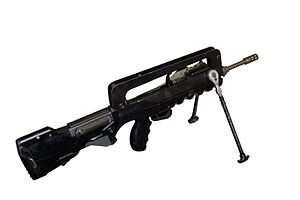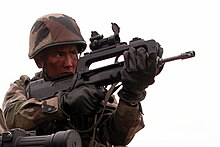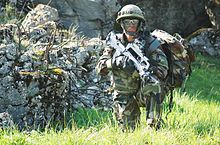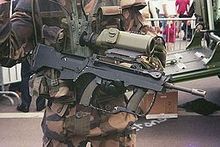FAMAS: Difference between revisions
New reference new user PNGDF |
No edit summary |
||
| Line 125: | Line 125: | ||
*{{flag|Senegal}}<ref name="Users"/> |
*{{flag|Senegal}}<ref name="Users"/> |
||
*{{flag|United Arab Emirates}}<ref name="bishop1998">Bishop, Chris. ''Guns in Combat''. Chartwell Books, Inc (1998). ISBN 0-7858-0844-2.</ref> |
*{{flag|United Arab Emirates}}<ref name="bishop1998">Bishop, Chris. ''Guns in Combat''. Chartwell Books, Inc (1998). ISBN 0-7858-0844-2.</ref> |
||
*{{flag|Papua New Guinea}}: ''[[Not officially however cited during 2012 mutiny]]<ref name="Geeks spot French rifles in PNG coup attempt" |
*{{flag|Papua New Guinea}}: ''[[Not officially however cited during 2012 mutiny]] <ref name="Geeks spot French rifles in PNG coup attempt"|url=http://www.http://asopa.typepad.com/asopa_people/2012/02/geeks-spot-french-rifles-in-png-coup-attempt.html|accessdate=29 February 2012}}</ref> <ref name="PNG's mutineers trade guns for amnesty"|url=http://www.theaustralian.com.au/news/world/pngs-mutineers-trade-guns-for-amnesty/story-e6frg6so-1226257690011|accessdate=29 February 2012}}</ref> |
||
== Sources and references== |
== Sources and references== |
||
{{reflist}} |
{{reflist}} |
||
Revision as of 11:22, 29 February 2012
This article needs additional citations for verification. (December 2008) |
| FAMAS | |
|---|---|
 FAMAS F1 | |
| Type | Assault rifle |
| Place of origin | |
| Service history | |
| In service | 1978–present |
| Used by | See Users |
| Wars | |
| Production history | |
| Designer | Paul Tellie[3] |
| Designed | 1967–1971 |
| Manufacturer | Nexter |
| Unit cost | F1: 1500 € G2: 3000 € |
| Produced | 1975–2000 |
| No. built | F1: 400 000 |
| Variants | F1 G1 G2 FAMAS Export FAMAS Civil FAMAS Commando |
| Specifications | |
| Mass | 3.61 kg (7.96 lb) (FAMAS F1) 3.8 kg (8.4 lb) (FAMAS G2) |
| Length | 757 mm (29.8 in) / 965 mm (38.0 in) with bayonet |
| Barrel length | F1, G2: 488 mm (19.2 in) G2 Commando:405 mm (15.9 in) G2 SMG:320 mm (12.6 in) G2 Sniper 620 mm (24.4 in) |
| Cartridge | 5.56x45mm NATO |
| Action | Lever-delayed blowback |
| Rate of fire | 900–1000 rounds/min (F1) 1000–1100 rounds/min (G2) |
| Muzzle velocity | 960 m/s (3,100 ft/s) (F1) 925 m/s (3,030 ft/s) (G2) |
| Effective firing range | 300 m (F1) 450 m (G2) |
| Maximum firing range | 3200 metres |
| Feed system | 25-round box magazine (F1) 30-round box magazine (STANAG system) (G2) |
| Sights | Rear aperture fitted with tritium night inserts, front post |
The FAMAS (Template:Lang-fr or "Assault rifle of the Saint-Étienne weapon factory") is a bullpup-styled assault rifle designed and manufactured in France by MAS located in Saint-Étienne, which is now a member of the French government-owned Nexter group. It is the service rifle of the French military.
History
The first French bullpup rifles were developed between 1946 and 1950 at the AME (Atelier Mécanique de Mulhouse) and MAS, testing rounds such as .30 US Carbine, 7.92x33mm Kurz, 7.65x38mm (Made by Cartoucherie de Valence) and some other intermediate calibers[citation needed]. Since France was engaged in the First Indochina War at the time, and was also the second-largest contributor to NATO, the budgets for new types of weapons were reduced and priority was given to the modernisation and production of existing service weapons. Nevertheless, approximately forty different prototypes were developed between 1952 and 1962, most of which were designed for the 7.62x51mm NATO round notably the FA-MAS Type 62 (the bayonet of which is used on the FAMAS). However the round was not found to be suitable for any bullpup designs, and consequently, none were adopted, and the ideas were set aside.[4][5][6][7] MAS then began to manufacture under licence the H&K G3 and the H&K 33 in the 1960s and studies were reactivated to produce a weapon using the new .223/5.56mm round. But the idea to develop and use German weapons was out of question for many members of the French high command. General Marcel Bigeard, against the idea to use German weapons, visited the Manufacture d'Armes de Saint-Étienne and asked the engineers to present him the different prototypes developed. He then chose, amongst different prototypes, what would become the FAMAS.
The FAMAS project began in 1967 under the direction of Paul Tellie and the first prototype was completed in 1971, with French military evaluation of the rifle beginning in 1972.[3] When production problems delayed the general issue of the new rifles, and with the 1978 Battle of Kolwezi showing the immediate need for a more modern weapon, the French Army began searching for a temporary rifle to fill this need until the FAMAS came into full production. The H&K 33 was considered, and a batch of 1200 examples were tested by Infantry, Airborne, Marines, Mechanised and Foreign troops, but it was ultimately turned down in favour of the SIG SG 540, built under licence by Manurhin, until enough FAMAS rifles were produced to begin general issue. The French military finally accepted the rifle in 1978 as the standard French combat weapon.
After adoption, the FAMAS F1 replaced the aging MAS 49/56 rifle and MAT-49 submachine gun, and approximately 400,000 FAMAS F1 assault rifles were produced, with production now complete. The F1 had many problems and was not completely reliable. For instance, the plastic pieces broke easily and the weapon jammed on occasions because of the poor disposable magazine concept. The first magazines were supposed to be disposables, but the budget of the French army never allowed it. The F1 was followed by the G1 that included several minor improvements such as redesigned grips, Magwell compatible with STANAG & FAMAS magazine and an enlarged trigger guard, but it remained conceptual and was never actually produced.
-
Soldier of the 2e REP with a FAMAS during the Gulf War.
-
French soldiers from the 27th Alpine Rangers Battalion and French Task Force Tiger patrol the valleys of Kapisa province, Afghanistan.
FAMAS G2
The FAMAS G2 was developed c. 1994 to bring the rifle more in compliance with NATO standards by having tighter rifling and accepting standard NATO magazines, but also included several other upgrades taken from the G1 model, such as the enlarged trigger guard and improved hand guards made of fiber glass, rather than plastics like on the F1. The French Navy purchased the FAMAS G2 in 1995, and began distributing it to the Fusiliers Marins and Commandos Marine, but the French Army has held off large scale purchase of the G2 to date, and the FAMAS F1 still remains the primary service rifle of the French Army and French Foreign Legion.
-
Photograph of a FAMAS-G2 with bayonet
-
F1 (top) compared to G2 (bottom). The G2 features
- a larger trigger guard
- a STANAG magazine
- a hand guard on the receiver under the muzzle
- a 1/9 rifling, instead of the 1/12 rifling of the F1
MAS .223
During the late 1980s, Century Arms imported a very small number of semi-automatic FAMAS' into the United States. However due to poor sales, production and importation ceased and the existing number are not only extremely rare but cost in the range of $8,000 with no spare parts available on the market.
FAMAS Infanterie

The FAMAS Infanterie is an improvement of the FAMAS F1, obtained by retrofiting an accessory rail onto the top of the handguard. This allows mounting combat optics, most notably reflex sights or the 4x magnification SCROME J4 scope.
Design details
Action

The FAMAS assault rifle is a bullpup configuration, with the ammunition feed behind the trigger. The receiver housing is made of a special steel alloy, and the rifle furniture is made of fiberglass. The rifle uses a lever-delayed blowback action, an action used on the AA-52 machine gun derived from the prototypes built during Army Technical Department tests having taken place between the First and Second World Wars.
Ergonomics
Fire mode is controlled by a selector within the trigger guard, with three settings: safe (central position), single shot (to the right), and automatic fire (to the left). Automatic fire can be in three-shot bursts (rafale) or fully automatic; this is determined by another selector, located under the housing and behind the magazine.
The FAMAS G2 weighs 3.8 kg (8.38 lb). The G1 and G2 have a large, grip-length trigger-guard like a Steyr AUG to allow easy access to the trigger when wearing gloves.
Both F1 and G2 models of the FAMAS feature a bipod attached to the upper hand-guard.
The FAMAS-G2 and some F1 sport a "polyvalent hand-guard" which features a standard NATO accessory rail, allowing a variety of sights to be mounted, notably red dot sights and night vision units.

The FAMAS features two alidades for aiming rifle grenades with several modes:
- direct fire at 75 or 100 metres, in anti-vehicle role
- indirect fire, in anti-personnel role:
- with the FAMAS inclined by 45°, allowing fire from 120 to 340 metres
- with the FAMAS inclined by 74°, allowing fire from 60 to 170 metres
In indirect fire mode the grenade support(more exactly named "grenade enforcement ring" in French) is moved forwards or backwards on the barrel which has markings (12/13?). This changes the position of the grenade on the barrel and automatically the volume of the chamber in which the gas expands to push the grenade forward. Each position of the grenade support has a number which is multiplied by a certain fixed number depending on the alidade position, 45° or 75°; this will accurately indicate the firing distance of the grenade.
Ammunition

The FAMAS F1 and G1, the original variants, were designed to use French-made 25-round magazines with 5.56x45mm cartridges. Due to the 1/12 rifling of the F1 barrel and its blowback action, ammunition must be a steel-case, French-made SS109 cartridge; using standard brass-case 5.56x45mm NATO causes overpressure and can cause malfunction.[8] The barrel of the G2 uses a 1/9 rifling, which enables it to use the SS109 or the M193 interchangeably.
During training with blank ammunition, a plug is added to the muzzle of the FAMAS. This plug is necessary for automatic or semi-automatic operation, which it allows by blocking part of the gas.
The FAMAS can use a variety of rifle grenades up to 500 grammes. Notable examples are the antipersonal APAV40 and the antitank AC58. It can also fire some hand grenades designed for this alternative purpose, notably the F2 grenade that includes a bullet trap. The FAMAS can accommodate an external grenade launcher as an add-on module under the hand guard; the US M203 grenade launcher is sometimes used.

- Rubber buttpad
- Removable stock
- Cheek rest. Can be reversed for right or left-handed shooter.
- Mobile assembly and ejection port
- Pins
- Bipod
- Handguard
- Charging Handle
- Grenade launcher sight
- Grenade support
- Muzzle brake/22 mm rifle grenade launcher
- Barrel
- Fire control selector: Safety, single shot, automatic
- Trigger
- Magazine release
- Magazine
- Serial number
- (right): 3-round burst or full automatic selector
(left): Sling ring
Service

The FAMAS first saw service in Chad during Operation Manta and again in desert operations in Kuwait during Operation Desert Storm and in other various peacekeeping missions. Officially, operational conditions proved the weapon to be reliable and trustworthy under combat conditions. The FAMAS is affectionately known as le Clairon ("the Bugle") because of its shape by French-speaking troops. An improved version of the FAMAS G2 is integrated in the Félin system.
Senegal and the United Arab Emirates received a small number of FAMAS F1 rifles from France,[9] though it was unknown when they received them. Djibouti uses this weapon in its military as the standard infantry weapon. The Philippines also received a limited number and is used by the Philippine National Police Special Action Force.[10]
Users
 Djibouti[11]
Djibouti[11] France: Used by the French Armed Forces since 1979, with over 700,000 rifles purchased.[2] Also used by several law enforcement agencies such as the Gendarmerie Nationale.[2]
France: Used by the French Armed Forces since 1979, with over 700,000 rifles purchased.[2] Also used by several law enforcement agencies such as the Gendarmerie Nationale.[2] Gabon[9]
Gabon[9] Indonesia: Komando Pasukan Katak (KOPASKA) tactical diver group and Komando Pasukan Khusus (Kopassus) special forces group.[12]
Indonesia: Komando Pasukan Katak (KOPASKA) tactical diver group and Komando Pasukan Khusus (Kopassus) special forces group.[12] Lebanon[11]
Lebanon[11] Senegal[9]
Senegal[9] United Arab Emirates[1]
United Arab Emirates[1] Papua New Guinea: Not officially however cited during 2012 mutiny Cite error: The
Papua New Guinea: Not officially however cited during 2012 mutiny Cite error: The <ref>tag has too many names (see the help page).
Sources and references
- ^ a b c Bishop, Chris. Guns in Combat. Chartwell Books, Inc (1998). ISBN 0-7858-0844-2.
- ^ a b c Marchington, James (2004). The Encyclopedia of Handheld Weapons. Lewis International, Inc. ISBN 1-930983-14-X.
- ^ a b "Modern Firearms – FAMAS". World.guns.ru. 24 January 2011. Retrieved 30 May 2011.
- ^ http://talks.guns.ru/forums/icons/forum_pictures/004217/4217682.jpg
- ^ Name *. "French MAS Type 1955". Forgotten Weapons. Retrieved 30 May 2011.
- ^ Name *. "French MAS Type 62". Forgotten Weapons. Retrieved 30 May 2011.
- ^ "FA-MAS Type 62". Securityarms.com. Retrieved 30 May 2011.
- ^ L'armée rencontre de sérieuses difficultés avec les munitions du fusil Famas
- ^ a b c Kemp, Ian (April–May 2007). "Assault rifles in a 5.56 mm evolution: the fielding of new designs and the upgrade of existing weapons will ensure that 5.56 mm remains the predominant assault rifle calibre". Armada International. Retrieved 16 April 2009.
- ^ "Famas F-1". Rifles n Guns. 2 January 2007. Retrieved 10 December 2008.
- ^ a b Jones, Richard D. Jane's Infantry Weapons 2009/2010. Jane's Information Group; 35 edition (27 January 2009). ISBN 978-0710628695.
- ^ "Kopassus & Kopaska – Specijalne Postrojbe Republike Indonezije" (in Croatian). Hrvatski Vojnik Magazine. Retrieved 12 June 2010.
External links
- Official Nexter FAMAS page
- FELIN article, with FAMAS pictured as part of FELIN system
- Modern Firearms
- REMTEK
- FAMAS with 50 round magazine



